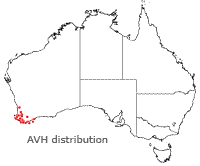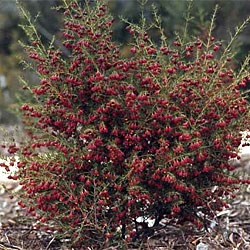Boronia megastigma
Brown Boronia
 Boronia megastigma, or Brown Boronia, is a small shrub native to southwestern Western Australia occurring from Perth to Albany.
Boronia megastigma, or Brown Boronia, is a small shrub native to southwestern Western Australia occurring from Perth to Albany.
Boronia megastigma grows to less than a metre. It has small leaves and small cup-shaped flowers, which occur in spring. The plant is quite striking in that the flowers are bright yellow inside whilst the exterior is an interesting red-brown colour. The flowers have a wonderful fragrance and are used in the production of essential oils.
Like many boronias, Boronia megastigma can be quite difficult to grow from seed. The seeds exhibit dormancy and are covered in a thick coating which prevents germination in all but ideal conditions in the wild. However, the plant is quite successfully grown from cuttings at the Australian National Botanic Gardens in Canberra.
Growing Boronia megastigma in a pot allows conditions to be controlled and kept consistent. B. megastigma requires cool, moist and well-drained soil, doing best in dappled shade. Mulching is useful to keep soil moist, as long as soil is free-draining as plants are prone to rot. The plant is sensitive to warm westerly winds in summer, so if grown in areas where such winds are likely it is recommended that it be placed on the east side of a wall or behind a windbreak of trees or shrubs. B. megastigma is adapted to nutrient-deficient soils and does not need fertilising, however it responds to application of slow release fertiliser after flowering. Unfortunately, B. megastigma does not do well in the tropics, requiring a cool period to initiate flowering, making B. megastigma an ideal plant for Canberra gardens. A number of attractive cultivars exist including 'Harlequin' ![]() with red and yellow striped flowers, 'Jack Maguire's Red'
with red and yellow striped flowers, 'Jack Maguire's Red' ![]() a red form, and a yellow form called 'Lutea'.
a red form, and a yellow form called 'Lutea'.
People growing Boronia megastigma tend to be disappointed in its relatively short lifespan, as it is a naturally fast-growing but short-lived plant in the wild. This can be mediated by regular but not harsh pruning after flowering in spring. Pruning is not recommended during times of stress. Many gardeners attest that the fragrance of B. megastigma definitely make it a worthwhile species to grow.
The main pest to look out for is scale, which can be controlled by physical removal or application of white oil for major outbreaks. Boronia megastigma is also susceptible to the fungus Phytophthora but this can be mediated by practising good garden hygiene to avoid spreading the fungus through contaminated soil.Text by Anna Senior (2011 Student Botanical Intern)
Name Meaning: Boronia megastigmaBoronia – after Francesco Borone, an 18th century Italian botanist. megastigma – referring to the large stigma. |
References
Turner, M. (2001) Propagating Boronia. Australian Plants online 23 September 2001. Available at http://anpsa.org.au/APOL23/sep01-1.html [Accessed February 2011].
Elliot, W.R. & Jones, D.L. (1984) Encyclopedia of Australian Plants Suitable for Cultivation Vol. 2 & 3, Lothian Publications, Melbourne.
Boronia 'Jack Maguire's Red', List of Australian Registered Cultivars. Available at http://www.anbg.gov.au/acra/descriptions/acc161.html [Accessed February 2011].
Clarke, B. 2011 (Pers. comm.) Horticulturist, Australian National Botanic Gardens.
Webb, M. (2006) Farmnote No. 47/96 ‘Growing boronia’, Western Australia Department of Agriculture and Food. Available at: http://www.agric.wa.gov.au/objtwr/imported_assets/content/hort/flor/cp/fn047_1996.pdf [Accessed April 2011].
![An Australian Government Initiative [logo]](/images/austgovt_brown_90px.gif)



